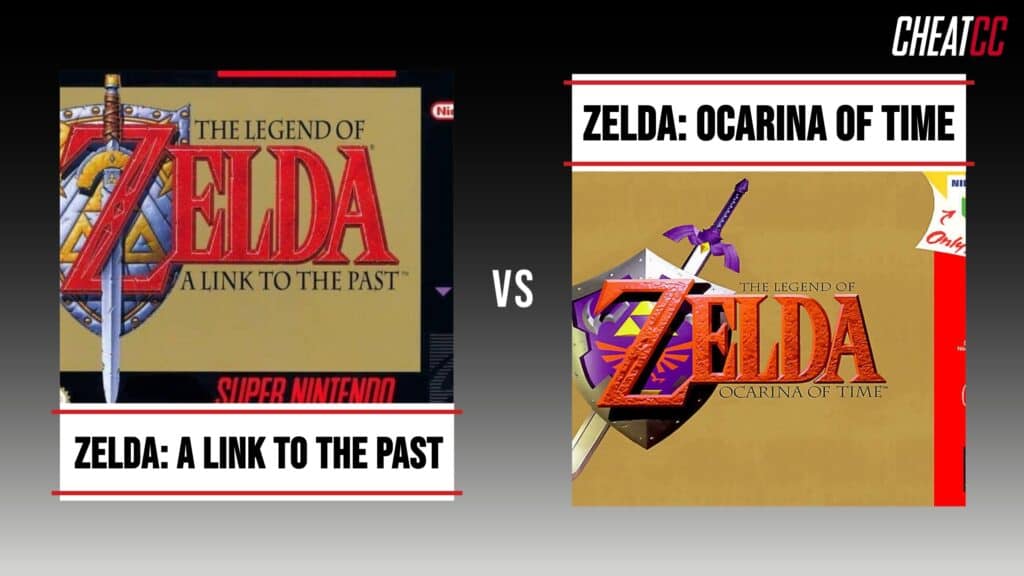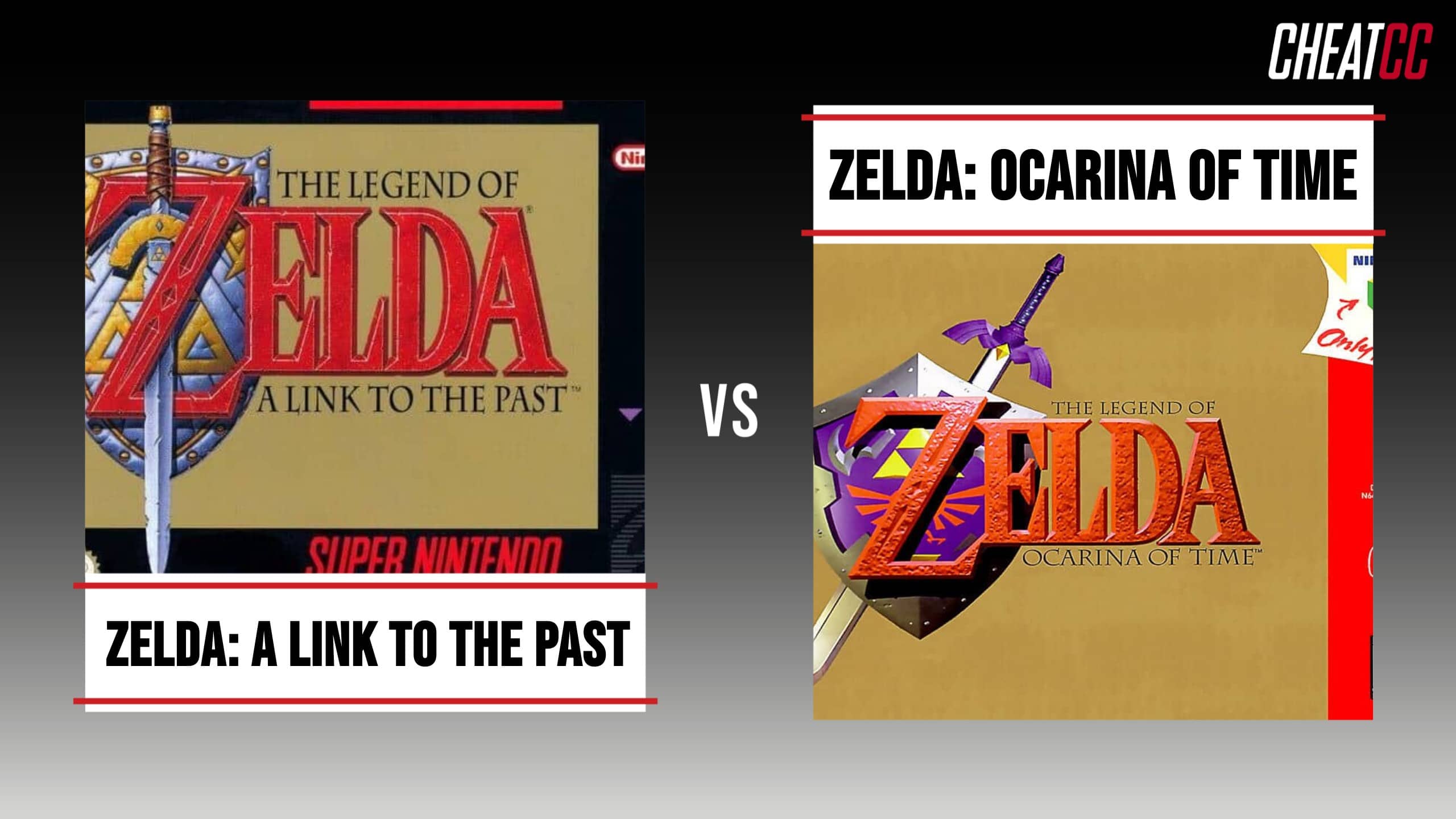One of the trademarks of the Zelda series is that each new entry is practically a generation-defining event. Since the release of the original Legend of Zelda, each new game in the series brings with it an air of moving the needle for game design as a whole. In terms of game franchises that have a significant bar of quality that remains consistent across all entries, few other series (if any) even come close to matching the impact of The Legend of Zelda. The battle of Zelda: A Link to the Past vs Zelda: Ocarina of Time is one that’s incredibly difficult to call, pitting the series’ best 2D title against one of its best 3D entries.
In terms of their overall impact on the series, only Breath of the Wild and its radical reinvention of The Legend of Zelda can compare with A Link to the Past and Ocarina of Time. After all, these are the two games that would go on to define the series’ 2D and 3D gameplay templates, respectively, and it’s safe to say that the Zelda series would look drastically different were it not for the elements that these two games bring to the table. Both titles are common inclusions in “best of all-time” lists, but determining one of these games to be the definitive “best” Zelda title is easier said than done.
Zelda: A Link to the Past vs Zelda: Ocarina of Time: Side-by-Side Comparison

One could be forgiven for assuming that more than a decade exists between the release of A Link to the Past and Ocarina of Time, but the truth is that these games represent a time capsule of one of the most significant technological leaps in the medium. The transition from 2D pixel-art sprites to full 3D between the 4th and 5th console generations is one of the more important seismic shifts in the history of video games, and it’s frankly amazing that the Zelda series encapsulates the best aspects of each dimension across these two titles. That the games were only released 6 years apart is even more astonishing and telling of the speed at which video game technology was developing at the time.
| Characteristic | Zelda: A Link to the Past | Zelda: Ocarina of Time |
|---|---|---|
| Release Year | 1991 (JP), 1992 (NA) | 1998 |
| Release Platform | Super Famicom/SNES | Nintendo 64 |
| Director | Takashi Tezuka | Eiji Aonuma |
| Producer | Shigeru Miyamoto | Shigeru Miyamoto |
| Review Aggregate Score | 93% | 99% |
| Total Sales | 7.43 million units | 14.04 million units |
| Sequels | The Legend of Zelda: A Link Between Worlds (3DS) | The Legend of Zelda: Majora’s Mask (Nintendo 64) |
| Number of Similar Games in the Series | 5 | 4 |
| Available on Nintendo Switch | ✅ | ✅ |
| Importance to the Franchise | Establishes 2D series formula moving forward; introduction of several recurring items and enemies | Establishes 3D series formula moving forward; introduction of several recurring items and enemies |
Zelda: A Link to the Past vs Zelda: Ocarina of Time: 5 Must-Know Facts
Here are 5 must-know facts when comparing A Link to the Past to Ocarina of Time:
- Both A Link to the Past and Ocarina of Time would prove to be incredible successes for Nintendo, both critically and commercially. While A Link to the Past is one of the best-selling and highest-scoring games on the SNES, Ocarina of Time more than doubles its commercial success and still holds the highest review aggregate score of any game in history.
- A Link to the Past is responsible for establishing the formula that every subsequent 2D Zelda game would follow. Similarly, the Zelda series’ 3D entries all use Ocarina of Time‘s design elements as their template until the release of Breath of the Wild.
- In terms of how each game impacts the Zelda series as a whole, A Link to the Past and Ocarina of Time both introduce several new items, enemies, and story and gameplay concepts that continue to show up time and again throughout the franchise.
- Ocarina of Time is the first game in the series to feature future Zelda mastermind and series producer Eiji Aonuma in the director’s chair, and his design sensibilities continue to forge the path forward for the franchise.
- While fans can look at the original Legend of Zelda as the first game in the series, it’s not until the release of A Link to the Past that the common elements of the franchise truly define themselves. Both it and Ocarina of Time are the games that establish what fans now call “Classic” Zelda in the wake of the series’ reinvention as an open-world title.
Zelda: A Link to the Past vs Zelda: Ocarina of Time: Critical and Commercial Reception
Zelda: A Link to the Past is the seventh-best-selling game in the history of the SNES’ lifespan, moving just under 5 million units on the console and serving as the only game in the franchise for the Super Nintendo. In comparison, Ocarina of Time stands as the fourth-best-selling game in the history of its platform, the Nintendo 64, going on to move nearly 8 million units during the 5th generation. While both games have strong sales figures, Ocarina of Time has more than doubled the commercial success of A Link to the Past across all versions, selling over 14 million units versus 7 million.
Similarly, A Link to the Past‘s critical reception would prove to be very strong, with the title holding a respectful 93% review aggregate score from publications around the time of its release. However, Ocarina of Time still holds the crown for the highest review aggregate score of any game in history, boasting a mighty 99% critical average across all major reviews. In terms of both its critical and commercial reception, Ocarina of Time is one of the most successful games of all time.
Zelda: A Link to the Past vs Zelda: Ocarina of Time: Establishing Precedent
There are 5 different 2D Zelda titles would be released following A Link to the Past, and each of them uses the design of the SNES classic as its template. Link navigates through an overworld map using a 2D, top-down perspective, completes a gauntlet of 8 or more dungeons to collect an important quest item, and gathers important pieces of equipment and abilities along the way in each of these titles. The same is also true of Ocarina of Time, which establishes the “3D Zelda” formula of every mainline series game that follows it. The first game in the series to not utilize Ocarina of Time’s design template would end up being 2017’s Breath of the Wild.
Zelda: A Link to the Past vs Zelda: Ocarina of Time: Impact on the Series
Many important figures at Nintendo would end up working within Nintendo EAD and getting the chance to contribute to The Legend of Zelda franchise. After creating the series and directing its first two entries, Shigeru Miyamoto would switch roles to become the series’ producer, mentoring several future Nintendo luminaries in the process. One of these is the lead designer and director of Ocarina of Time, Eiji Aonuma, who now serves in a similar role to Shiger Miyamoto as the lead producer and mastermind behind the direction of the Zelda franchise. In that regard, Ocarina of Time can be seen as the proverbial “passing of the torch” between two distinct eras of the franchise.
Zelda: A Link to the Past vs Zelda: Ocarina of Time: Defining “Classic” Zelda
Now that the Zelda series is firmly in its new open-world era with both Breath of the Wild and Tears of the Kingdom, looking back on the series’ past shows some consistency across all of the mainline entries. Those consistencies can each trace their genesis back to one of two paradigm-shifting games in the series — A Link to the Past or Ocarina of Time. As such, both of these titles now represent the purest distillation of what fans affectionately refer to as “Classic” Zelda, and it will be interesting to see how the series continues to evolve while still paying homage to these two titles and the elements of the series they each introduce.
Bottom Line
Fans old enough to remember the release of the original Legend of Zelda will likely always hold a special place in their hearts for A Link to the Past. Not only is it one of the best Zelda games and one of the best games in the SNES library, it’s a strong contender for being one of the best games ever, period. Truthfully, though, you could say the exact same of Ocarina of Time. Not only is the title the perfect encapsulation of the Zelda gameplay formula in 3D, its release marks a massive perspective shift within the industry, proving that 2D game franchises could work as immersive experiences in 3D at a time when the technology was in its infancy.
One could argue that Ocarina of Time just takes A Link to the Past‘s formula and successfully translates it into 3D, which makes determining a winner among the two titles for “best Zelda game” even more difficult. Ultimately, Ocarina of Time stands tall as the definitive “best” game in the Zelda series thanks to its astounding critical and commercial reception, its importance to the series’ future entries, and the way that its design elements are continually felt in games released today, Zelda or otherwise.
